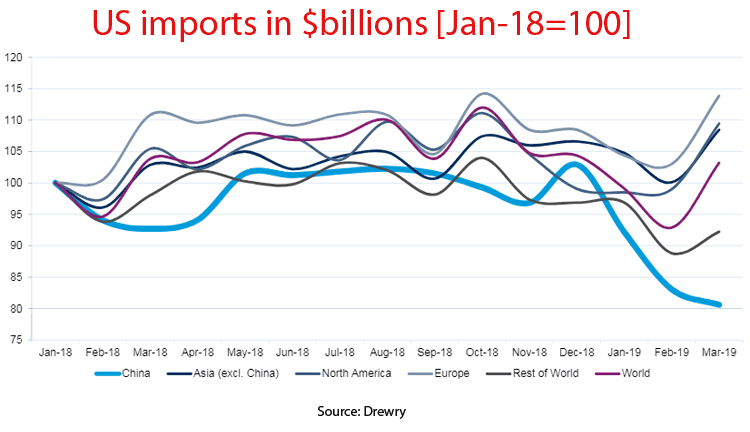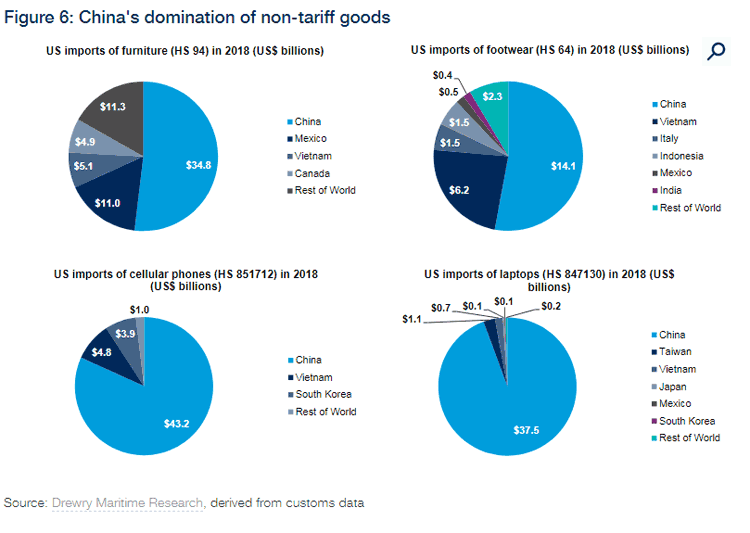The tariff war between the US and China continues on, though markets rallied this week after President Trump said there "is a chance" of a trade deal being made with China at next week's G-20 meeting in Japan.
The analysts at Drewry follow the global container shipping industry, which is obviously much affected by trade flows and volumes.
Supply Chain Digest Says... |
|
|
It recently analyzed the tariff impacts thus far and where things may be headed, noting that the US' "weaponization of tariffs is forcing cargo owners to seek cover and re-shape global supply chains to avoid the fallout. There is very clear evidence from customs data that trade flows into the US have moved away from China to other locations of origin over the past year or so."
As evidence of that, look at the chart below, which shows imports of Chinese goods to the US have fallen sharply since the end of 2018, while those from other regions are on the rise.
For many companies, switching sourcing locations is a difficult challenge, for a myriad of reasons, including the lack of a supply base for the main supplier, logistics challenges, the regulatory environment, and more.
In addition, having identified a new location, there can be no guarantees that the new countries a company moves to for sourcing won't find themselves being targeted by future US tariffs.
As an example, Mexico is certainly a growing alternative to China – but Trump was days away from applying a 5% tariff on all Mexican imports – a level that was expected to continue to rise – over issues with how Mexico is handling the flood of Central American migrants crossing the country on the way to the US border.
Howeverm after Mexico took some action, the US said those tariffs would be "indefinitely suspended."

But there seems no question there is some drift away from Chinese sourcing for US companies. But can it continue?
Drewry notes that in some product categories the dominance of Chinese as a supply source makes an already tough challenge of moving away from China even tougher.
(See More Below)
|
CATEGORY SPONSOR: SOFTEON |
|
|
|
|
|
As shown in another chart from Drewry, China's dominance in such product classes as footwear, cell phones and laptops - not subject to tariffs yet - is so strong that finding new supply sources outside of China is an extremely difficult and slow process.

And while there is anecdotal evidence of more companies recently binging production back to the such as any announcement relative to reshoring last week by retailer Restoration Hardware, ADrewry observes Asian countries excluding China have been one of the fastest growing exporters to America. The trade deficit, in other words, will perhaps fall with China, but may increase with countries such as Vietnam.
What's more, Drewry says "there are anecdotal reports that Chinese goods are being transhipped to places such as Vietnam and Malaysia, simply to have the Made in China label replaced to avoid the duties. If true, this gaming of the US tariffs means extra Intra-Asia traffic, a positive for shipping lines in the region."
The changes will have other impacts on global logistics. Transpacific volumes are likely to dip as demand for the large number of Chinese goods that cannot readily be substituted wanes amid cost rises.
Some of that will be made up by imports to the US from other Asian countriies, but Drewry notes transpacific shipping schedules will need to be broadened to reach more non-Chinese ports. The relative scarcity of direct port links in other parts of Asia to the US is already being reflected in higher freight rates, Drewry says.
Drewry ends by noting that "It seems likely that all Chinese goods will be touched by tariffs in the near future. This will expedite trade diversion, but it will take time for other locations to ramp up the production capacity to meet demand and in some cases it is doubtful this is a possibility due to China's dominance of certain products. Further trade attacks on other US partners could slow the process"
The bottom line: the only certainty right now is uncertainty.
Do you think the tariffs will big impact on global trade flows? In the short or long term? Let us know your thoughts at the Feedback section below.
Your Comments/Feedback
|